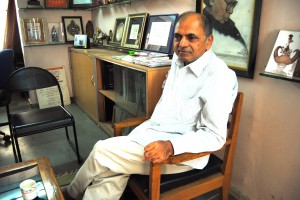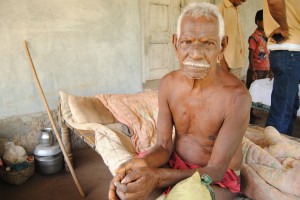By Kelly Virella (class of 2003)
 AHMEDABAD, India, March 2003 – When temperatures hit 105 degrees Fahrenheit, 35 patients lay in an infirmary without air-conditioning, in beds separated by less than three feet of space. But among the poor in this city of five million, they were the lucky ones.
AHMEDABAD, India, March 2003 – When temperatures hit 105 degrees Fahrenheit, 35 patients lay in an infirmary without air-conditioning, in beds separated by less than three feet of space. But among the poor in this city of five million, they were the lucky ones.
A woman with jaundice, who had an IV in her arm, lay in her bed and explained why. She had been in the hospital for four days, but owed less than $8 for her stay. That’s 90 percent less than what she would have paid at a private hospital.
“Here we get doctors full time, 24 hours a day,” she said. “It’s as good as private practice, for a very nominal charge. Even better than government hospital.”
It’s cheap and by many accounts good health care, but somebody, somewhere down the line, has to pay. That’s where the Vishwa Hindu Parishad (Council) or the World Hindu Council comes in, a 37-year-old religious-cultural group with offices in 42 countries, including the United States.
Although the Council carefully avoids calling itself a political organization, its growth is good news for the Bharatiya Janata Party (BJP), which now rules India. The Council’s story in Gujarat offers a glimpse of how the ruling BJP hopes to keep increasing its seats in Parliament.

One year after the communal violence between Muslims and Hindus, this bed is the only item left in the relief camp for Muslims whose homes were burned. Photograph by Mimi Chakarova.
The Council that runs the hospital is the same led by people named in police records in riots that killed more than 1,000 Muslims in March of 2002. Following the riots, the Council distributed brochures across this city against Muslims — who make up less than 9 percent of Gujarat’s 51 million people — calling them “traitors and terrorists” and asking Hindus to “save our country by boycotting Muslims economically and socially.”
Such facts hardly faze Dr. Hitesh Ramanuj, the chief of staff of the hospital, who is also the head of a city-level branch of the Council. He says his organization is honored to fund and run the hospital. “It’s not a totally fascist organization,” he said. “I didn’t join the organization because it was a fascist organization. I joined because it had a social service component.”
It’s this “social service component,” many say, that the Council is using to hide a shrewd strategy to win over destitute, low-caste Hindus, a constituency that has traditionally shown little support for its brand of anti-Muslim ideology. The strategy seems to be working.
Some of the strongest evidence is in Bapunagar, the predominantly low-caste, Hindu slum of 75,000 residents, where Shree Dhanvantry hospital is located. Bapunagar is named after Mahatma Gandhi who was born in Gujarat and was called Bapu (father of the nation).
With nearly 20,000 laid-off textile mill workers, it’s a sort of refugee camp for people who lost their jobs in the early ’80s and ’90s, when changes in technology and government mismanagement shut down all but six of Ahmedabad’s 61 mills. Already, the Council has recruited an estimated 7,000 members here, including the jaundiced woman.
These numbers are key to the Council’s growth. The Council champions an ideology called Hindutva. Loosely, this means ensuring a Hindu state for India where minorities, notably Christians and Muslims, “should know their place.”
This ideology dovetails with that of the BJP. Political observers say that if the BJP is Hindutva’s brain, the Council is its brawn.
 The BJP has reaped rich political dividends thanks to the Council’s “mass-contact programs.” These include several campaigns across the country against “cow slaughter,” (Hindus revere the cow) and against conversion of oppressed low-caste Hindus to Islam or Christianity.
The BJP has reaped rich political dividends thanks to the Council’s “mass-contact programs.” These include several campaigns across the country against “cow slaughter,” (Hindus revere the cow) and against conversion of oppressed low-caste Hindus to Islam or Christianity.
Council leaders and activists played a key role in the demolition of a 450-year-old mosque in the northern India town of Ayodhya in 1992 and are now threatening to defy court orders to build a Hindu temple there. All this has come in handy for the BJP: from just two seats in the 545-member Parliament in 1980, the BJP now has 182.
The first ones to jump onto the Hindutva bandwagon were upper-caste, urban middle-class Hindus. Many political observers feel that with these voters under its belt, the BJP is looking at making inroads into the poor, low-caste Hindus, who make up over 52 percent of the country’s population and have traditionally sided with India’s leading opposition party, the Congress Party. The Dhanvantry hospital and other elements of the Council’s “social service component” in villages are designed to deliver these members.
However, some say that it goes deeper than that. “Charity is there, but it is basically a superficial thing,” said Gurang Jani, a sociology professor at Gujarati University. “They just want to create the Hindu fundamentalist mind in the new generation. They want to create this radical Hinduism. They are not changing the community. They are just creating havoc.”
And for this, no ground is more fertile than Gujarat. Of the Council’s estimated 4 million members nationwide, about 1.5 million come from this state alone — a 20 percent growth over the last five years. Gujarat is also the only state where the BJP is in power and where it has a special relationship with the Council.
In the national government, the BJP rules in a coalition of more than 20 parties and is often embarrassed by the Council’s brand of Hindutva since its shrill anti-Muslim rhetoric makes partners nervous — some have even threatened to quit if the Council isn’t reined in. In the Gujarat legislature, however, the BJP is in power alone and doesn’t need to look over its shoulder every time the Council raises the heat as it did during the riots, leading the mobs and fueling the violence.

During the communal violence in Gujarat, many Muslims were burned alive. This boy managed to escape but the scars on his body will always remain as a reminder. Photograph by Mimi Chakarova.
Our hands are clean of Muslim blood, says D.K. Akruwala, vice-president of the Gujarat branch of the Council. He says the Hindus who started the riots simply got upset when they heard how a Muslim mob had set a train on fire, killing 59 Hindus near here. “Do you expect that there would not be any reaction?” he yelled. “The reaction to burning 59 persons was burning 1,000 people. It was a reaction of the people.” All the Council did, Akruwala said, was help Hindus organize their defense. “Our agency is responsible for protecting the afflicted.”
That wasn’t all the Council did. In the elections that followed the riots, several Council members — from the top brass down to neighborhood activists — threw their weight behind the BJP. Not only did Council leaders share the campaign stage with BJP candidates, they mobilized voters, distributed pamphlets and called for a boycott of the Congress Party. At one campaign rally, Pravin Togadia, a former Ahmedabad-based surgeon and now the Council’s No. 2 man, ridiculed Sonia Gandhi, the president of the Congress, as an “Italian dog,” a reference to her Italian origins. Riding on a wave of such a campaign whipped up by the Council, the BJP won a landslide victory in Gujarat, securing two-thirds of the seats in the state assembly.
Dinesh Shukla, Gujarati University professor emeritus of political science, estimates that 20 to 25 percent of the BJP’s newly elected legislators are Council members. It wasn’t surprising, therefore, when just last month, the party pushed through the Gujarat state assembly a Council-backed law punishing with fines some conversions to Islam.
Yet even before the election, there was evidence the Council was reaching the masses. Poor, low-caste Hindus who had lived side-by-side with poor Muslims for decades allegedly raped, burned and mutilated their Muslim neighbors during last year’s riots, which were the most gruesome of the five that have occurred here in the past 35 years. What surprised many was how for the first time, the BJP made enormous gains in predominantly low-caste villages and districts which were traditional Congress bastions.
 But Dr. Jaideep Patel, the man who runs the Gujarat branch of the Council, said low-caste Hindus are not his targets. “No, no, no,” he said, sitting behind his desk, flailing his hands. “All Hindu people are connecting with the Council,” from Brahmins to the untouchables.
But Dr. Jaideep Patel, the man who runs the Gujarat branch of the Council, said low-caste Hindus are not his targets. “No, no, no,” he said, sitting behind his desk, flailing his hands. “All Hindu people are connecting with the Council,” from Brahmins to the untouchables.
“These (the charitable works) are not the workings of a fascist organization,” said Patel, who was shot in the head in an assassination attempt that he says left him unconscious for 15 days. “Who is the fascist?” he said. “The one who shoots or the one who takes the bullet?”
But Hanif Lakdawala, a Muslim psychiatrist and civil rights leader who runs a medical clinic for poor Hindus and Muslims, said “fascists” set up hospitals, take bullets and shoot them, too. “We’re up against very formidable forces,” he said. “Hatred against Muslims has become part of the collective consciousness of Gujarati Hindus.”







